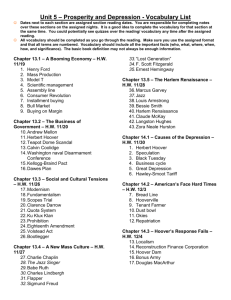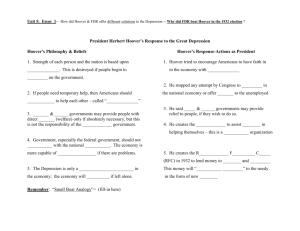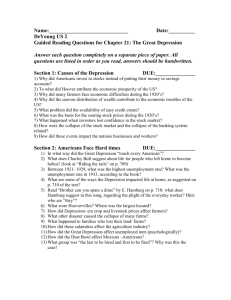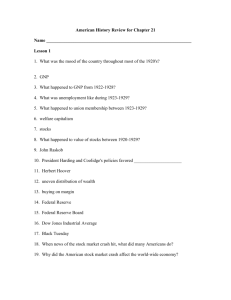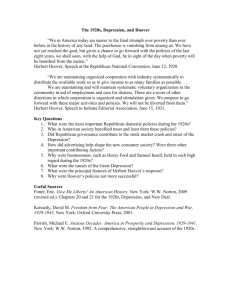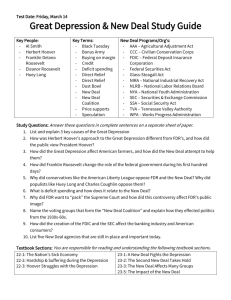Great Depression Workbook: Chapter 14 - American History
advertisement
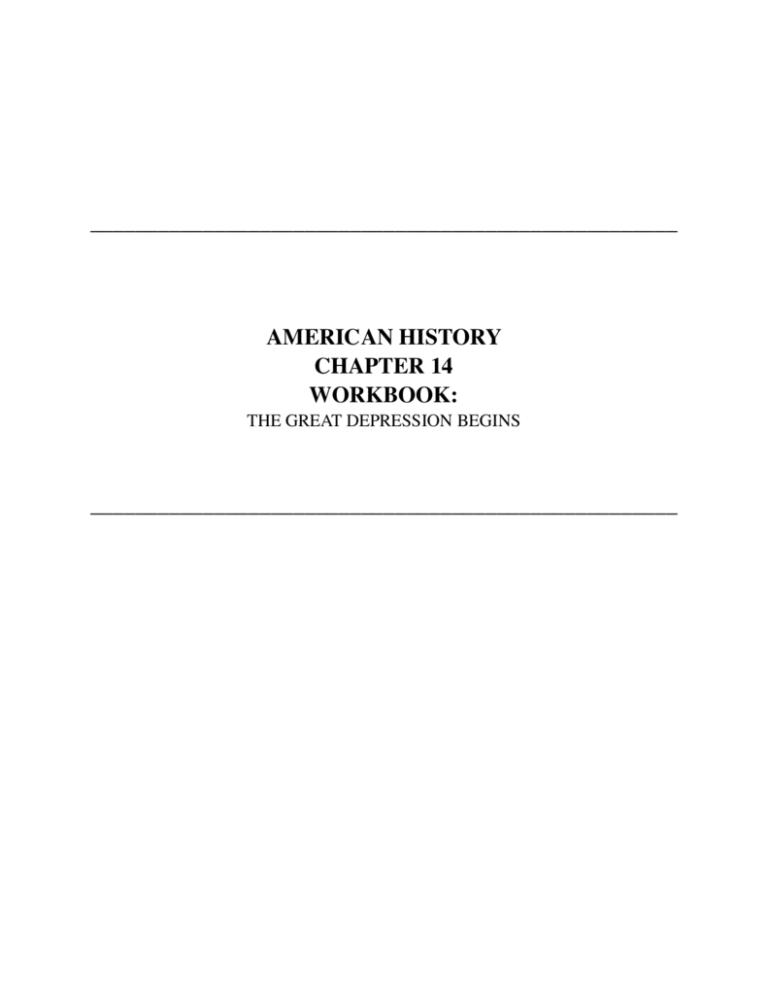
____________________________________________________ AMERICAN HISTORY CHAPTER 14 WORKBOOK: THE GREAT DEPRESSION BEGINS ____________________________________________________ Name _____________________________ Class _________________ Date __________________ The Great Depression Begins Section 1 The Nation’s Sick Economy Terms and Names price support Law that keeps prices above a set level credit Short-term loans to buy goods with promises to pay later Alfred E. Smith Democratic presidential candidate in 1928 Dow Jones Industrial Average Index of stock prices of select companies speculation Investments in high-risk ventures buying on margin Buying stock by paying only a portion of the full cost up-front with promises to pay the rest later Black Tuesday October 29,1929, the day the stock market crashed Great Depression Period of bad economic times in the United States that lasted from 1929 to 1940 Hawley-Smoot Tariff Act Law that raised taxes on imports and worsened the Depression Before You Read In the last section, you learned about the Harlem Renaissance in the 1920s. In this section, you will read about the economic problems that led to the Great Depression. As You Read Use a web diagram to take notes on the causes of the 1929 stock market crash. ECONOMIC TROUBLES ON THE HORIZON (Pages 464–466) Why was the nation’s economy sick in the late 1920s? During the 1920s, the economy boomed. But there were economic problems under the surface. Industries, such as clothing, steel-making, and mining, were hardly making a profit. Many industries had been successful in the early 1920s. But by the late 1920s, they were losing money. These industries included auto manufacturing, construction, and consumer goods. The biggest problems were in farming. After the war, the demand for food dropped and farmers suffered. Farmers’ incomes went down. Many could not make the mortgage payments on their farms. As a result, many farmers lost their land. Congress tried to help farmers by passing price supports. With price supports, the government would not allow food prices to fall below a certain level. But Calvin Coolidge vetoed the bill. Farmers’ incomes continued to drop. Farmers were not the only problem with the economy. Americans were buying less. Many found that prices were rising faster Original content © Houghton Mifflin Harcourt Publishing Company. Additions and changes to the original content are the responsibility of the instructor. 194 Guided Reading Workbook Name _____________________________ Class _________________ Date __________________ Section 1, continued THE STOCK MARKET CRASHES than their salaries. Many people bought goods on credit—an arrangement in which consumers agreed to make monthly payments with interest. But too many Americans were accumulating debt they could not afford to pay off. In the late 1920s, much of America seemed prosperous, but there was an uneven distribution of income. A small number of rich people were getting richer. But a large number of people were not doing well and falling further behind. (Pages 467–469) What was Black Tuesday? Stock prices did begin to fall in September 1929. On Tuesday, October 29, 1929, called Black Tuesday, prices fell so sharply that people said the market had “crashed.” People frantically tried to sell their shares which drove prices down further. There were no buyers. Many people lost all their savings. By midNovember, $30 billion—more than America had spent in World War I—had been lost. 1. What problems did farmers face in the 1920s? 3. What happened on Black Tuesday? ______________________________ _______________________________ ______________________________ _______________________________ HOOVER TAKES THE NATION (Pages 466–467) FINANCIAL COLLAPSE How healthy was the stock market? Few people recognized the problems with the economy in 1928. The Republican Herbert Hoover easily defeated the Democratic challenger, Alfred E. Smith. People believed Hoover when he said the American economy was healthy. The Dow Jones Industrial Average, a measure of 30 popular stocks, was way up. People rushed to buy stocks. Many people were engaging in speculation, buying risky stocks in hopes of a quick profit. To do so, they were buying on margin—paying just a small down payment and borrowing the rest. The problem of buying on margin was that there was no way to pay off the loan if the stock price declined sharply. (Pages 469–471) How did the stock market crash affect businesses? The stock market crash signaled the Great Depression. This period of bad economic times when many people were out of work lasted from 1929 to 1940. Although the crash did not cause the Depression, it did make it worse. After the crash, many people panicked and took their money out of banks. Many banks were forced to close. When the banks failed, other depositors lost the savings they had in the banks. Businesses also began to close. Millions of Americans lost their jobs. Workers who kept their jobs experienced pay cuts or reduced hours. The Depression spread around the world. Germany was still paying war reparations. Other European countries were struggling with debts from the war. With Americans unable to buy their goods 2. What was dangerous about how Americans bought stock? ______________________________ ______________________________ Original content © Houghton Mifflin Harcourt Publishing Company. Additions and changes to the original content are the responsibility of the instructor. 195 Guided Reading Workbook Name _____________________________ Class _________________ Date __________________ Section 1, continued • A crisis in the farm sector now, European economies suffered even • The availability of easy credit more. • An unequal distribution of income The situation became worse when These factors led to a falling demand Congress passed the Hawley-Smoot for consumer goods. The federal Tariff Act. Congress hoped that higher government hurt the economy with its tariffs would push Americans to buy policy of low interest rates causing goods made in the United States. The businesses and consumers to borrow easily result would be to help American industry. and build up too much debt. Instead, when the United States charged more to bring goods in, imports from 4. Why did many banks fail after the Europe declined. Then Europeans had stock market crashed? even less money to spend on U.S. goods, _______________________________ and American industry suffered. The Great Depression had several _______________________________ causes: • Tariffs and war debt policies that cut down the foreign market for American goods Original content © Houghton Mifflin Harcourt Publishing Company. Additions and changes to the original content are the responsibility of the instructor. 196 Guided Reading Workbook Name _____________________________ Class _________________ Date __________________ Section 1, continued As you read this section, take notes to describe the serious problems in each area of the economy that helped cause the Great Depression. 1. Industry 3. Consumer spending 2. Agriculture 4. Distribution of wealth 5. Stock market Original content © Houghton Mifflin Harcourt Publishing Company. Additions and changes to the original content are the responsibility of the instructor. 197 Guided Reading Workbook Name _____________________________ Class _________________ Date __________________ The Great Depression Begins Section 2 Hardship and Suffering During the Depression Terms and Names shantytown A neighborhood where people live in shacks soup kitchen Place where free food is served to the needy bread line A line of people waiting for free food Dust Bowl Area of the Great Plains made worthless for farming by drought and dust storms in the 1930s direct relief Money or food given directly from the government to the needy Before You Read In the last section, you learned about the start of the Great Depression. In this section, you will read about the hardships caused by the Depression. As You Read Use a Venn diagram to take notes on the effects of the Great Depression on farmers and city dwellers. Find the similarities and the differences. THE DEPRESSION DEVASTATES PEOPLE’S LIVES (Pages 472–474) How did the Depression affect people in cities and on farms? The Depression brought suffering and hardship to many Americans. The hard economic times ruined many lives. Millions of people lost their jobs. Some went hungry or became homeless. Those who could not meet their housing payments were thrown out of their homes. Cities across the country were full of these homeless people. Some slept in parks and wrapped themselves up in newspapers to keep warm. Others built shantytowns, where they lived in little shacks they made out of scrap material. Some ate in soup kitchens, where charities served meals to the needy. Those who could not afford to buy food stood in bread lines to receive free food. African Americans and Latino Americans who lived in the cities had a very hard time. They had a higher unemployment rate than whites. If they did have work, they were paid less than white workers. There was even violence directed against African Americans and Latinos. Angry whites who had lost their jobs did not want to compete against these minority groups for the few jobs that were left. They sometimes attacked African Americans. They demanded that Latino Americans be sent back to the countries they came from. The Depression hurt people in rural areas, too. Food prices continued to go down as the Depression deepened. Original content © Houghton Mifflin Harcourt Publishing Company. Additions and changes to the original content are the responsibility of the instructor. 198 Guided Reading Workbook Name _____________________________ Class _________________ Date __________________ Section 2, continued stayed home. They played board games or listened to the radio. But some families broke apart under the strain of poverty and unemployment. Many men felt ashamed because they had lost their jobs. Some of them simply left their families and wandered the country looking for work. Women tried to find work, too. But they were usually paid less than men. Many people complained that employers should not hire women. They thought that men should have the jobs instead. These people argued that men were the ones who supported families, so it was more important for them to have jobs. Children suffered terribly from poverty and the break-up of families. Many children had poor diets and no health care. Their parents could not afford to buy healthy food or to pay doctor bills. Many children suffered from malnutrition and diet-related illnesses like rickets. Many children ran away from home, hopping rides aboard freight trains. It was exciting, but also dangerous. Many were robbed or killed by criminals or beaten by railroad guards. During the early years of the Great Depression, the federal government did not give direct relief—cash or food directly to poor people. Charities and some city governments struggled to help. But they could not provide enough relief to keep people out of poverty. Because so many people were out of work, cities and states collected less tax money. They had to cut their budgets for programs like child welfare. Some cities could not afford to keep their schools open for a full term. Many school boards shortened the school year. Other schools simply closed. Children often went to work to try to help their families survive. Farmers earned less and less. Many farm families could not meet their mortgage payments. More and more of them lost their farms. From 1929 to 1932, about 400,000 farmers lost their land. To make matters worse, a long drought hit the Great Plains. There was little rain from Texas to North Dakota. Much of this area had been grassland that farmers broke up with their plows in order to grow crops. The soil was now exhausted from overfarming. The grass that had once held the soil in place was gone. When powerful winds swept across the Great Plains, the soil simply blew away. This dry area of blowing soil was called the Dust Bowl. Huge dust storms covered the plains and blew dust as far away as the East Coast. The hardest hit region included parts of Kansas, Oklahoma, Texas, New Mexico, and Colorado. Many Oklahoma farmers packed up their belongings and started for California to look for work. They became migrant workers, moving from place to place to pick crops. Because so many of them came from Oklahoma, migrant workers were often called Okies. 1. How did people in the cities and in rural areas suffer during the Great Depression? ______________________________ ______________________________ EFFECTS ON THE AMERICAN FAMILY (Pages 474–477) How did the Depression affect families? The Depression put a heavy strain on family life. Many families pulled together during the hard times. They shared what they earned. Instead of going out for entertainment, parents and children often Original content © Houghton Mifflin Harcourt Publishing Company. Additions and changes to the original content are the responsibility of the instructor. 199 Guided Reading Workbook Name _____________________________ Class _________________ Date __________________ Section 2, continued resources with their neighbors or gave food and clothing to the needy. The Great Depression caused great suffering. Rates of suicide and mental illness increased dramatically. Hardship forced young people to give up dreams of college. While the Great Depression caused much suffering, it sometimes brought out the best in individuals, families, and communities. Many people shared 2. Describe two ways the Great Depression affected families. _______________________________ _______________________________ Original content © Houghton Mifflin Harcourt Publishing Company. Additions and changes to the original content are the responsibility of the instructor. 200 Guided Reading Workbook Name _____________________________ Class _________________ Date __________________ Section 2, continued As you read about how people coped with hard times, use the chart below to summarize the Great Depression’s effects on various aspects of American life. 1. Employment 2. Housing 3. Farming 4. Race relations 5. Family life 6. Physical health 7. Emotional health Original content © Houghton Mifflin Harcourt Publishing Company. Additions and changes to the original content are the responsibility of the instructor. 201 Guided Reading Workbook Name _____________________________ Class _________________ Date __________________ The Great Depression Begins Section 3 Hoover Struggles with the Depression Terms and Names Herbert Hoover 31st president Boulder Dam Dam on the Colorado River built during the Depression to create jobs Federal Home Loan Bank Act Law passed in 1931 to reduce mortgage rates to save farmers from foreclosure Reconstruction Finance Corporation Agency established in 1932 to provide emergency relief to large businesses, insurance companies, and banks Bonus Army Unemployed World War I veterans who marched to Washington to demand their war bonuses Before You Read In the last section, you read about how the Depression affected common people. In this section, you will learn how President Hoover tried to stop the Depression. As You Read Use a web diagram to take notes on President Hoover's response to the Great Depression. HOOVER TRIES TO REASSURE THE NATION (Pages 478–481) How could the nation recover? Economic slowdowns occur regularly. Over time, economies go through cycles. There are times of economic growth and prosperity. They are followed by slumps when the economy slows down. In the 1930s, many experts believed that it was best not to interfere with these economic cycles. They argued that slumps would end on their own and good times would return. At first, President Herbert Hoover believed that the Great Depression was just another slowdown that would end on its own. His advisors thought that it was best to do nothing. The economy would heal itself. Hoover believed the government should take some action. But he also believed that government should not take too much power or give direct aid to poor people. Hoover believed government should help different groups work together to improve the economy. For example, Hoover thought government should help managers and workers find solutions to their problems. But he did not think government should decide on the solution. Hoover also believed in “rugged individualism”—the idea that people should succeed through their own efforts. He believed people should take care of themselves and each other, and that the government should encourage private Original content © Houghton Mifflin Harcourt Publishing Company. Additions and changes to the original content are the responsibility of the instructor. 202 Guided Reading Workbook Name _____________________________ Class _________________ Date __________________ Section 3, continued could encourage cooperation between private groups. He tried to help farmers with the Federal Farm Board, and banks by creating the National Credit Corporation. Another program tried to raise the prices farmers received for their crops. Hoover also urged bankers to join a credit organization. It gave loans to banks that were in danger of failing. By 1931, the economy had not improved. Congress passed the Federal Home Loan Bank Act. This law lowered mortgage rates. Congress hoped that low mortgage rates would help farmers change the terms of their mortgages. This would help protect their farms from foreclosure. Hoover also created the Reconstruction Finance Corporation. The RFC provided money for projects to create jobs. Hoover became less popular with the public. His popularity fell even more in 1932 when World War I veterans came to the capital. These veterans had been promised bonuses to make up for their poor wartime pay. Congress was about to vote on a bill to give the veterans their bonuses immediately. Thousands of veterans and their families came to Washington. This socalled Bonus Army set up tents to live in near the Capitol building. Hoover first sent the veterans food. But after the bonus was voted down in Congress, Hoover told the veterans to leave. About 2,000 stayed. Hoover ordered the army to remove them. The sight of U.S. Army troops using tear gas on citizens outraged many people. groups to help the needy. He thought that charities—not government—should give food and shelter to people who were poor or out of work. Hoover felt that government could guide these private relief efforts. None of these steps made a difference. The economy shrank and unemployment continued to go up. One project that did help was the Boulder Dam, a huge dam on the Colorado River. Still, economic difficulties increased, the country turned against Hoover. In the 1930 elections, the Democrats gained more seats in Congress. Farmers burned crops and dumped milk rather than sell it for less than it cost them to produce it. People called the shantytowns that sprang up “Hoovervilles.” Despite public criticism, Hoover stuck to his principles. Hoover met with bankers, businessmen, and labor leaders. He urged them to work together to help improve the economy. He asked employers not to fire workers or to lower their pay. He asked labor leaders not to ask for higher pay or to strike. 1. What did Hoover think government should do in bad economic times? ______________________________ ______________________________ HOOVER TAKES ACTION; GASSING THE BONUS ARMY (Pages 481–483) What did Hoover do? Hoover did not offer direct aid to the poor. But he did worry about the suffering of the people. He took steps to use the government to improve the economy. Hoover used the Boulder Dam project as a model of how the federal government 2. What actions did Hoover take to improve the economy? _______________________________ _______________________________ Original content © Houghton Mifflin Harcourt Publishing Company. Additions and changes to the original content are the responsibility of the instructor. 203 Guided Reading Workbook Name _____________________________ Class _________________ Date __________________ Section 3, continued As you read about President Hoover’s response to the Great Depression, write notes in the appropriate boxes to answer the questions. Philosophy 1. What was Hoover’s philosophy of government? Response and Economic Results 2. What was Hoover’s initial reaction to the stock market crash of 1929? 3. a. What was the nation’s economic situation in 1930? b. How did voters in 1930 respond to this situation? 4. a. What did Hoover do about the economic situation? b. How did the economy respond to his efforts? 5. a. How did Hoover deal with the economic problem posed by the Bonus Army? b. How did his efforts affect his own political situation? Original content © Houghton Mifflin Harcourt Publishing Company. Additions and changes to the original content are the responsibility of the instructor. 204 Guided Reading Workbook

